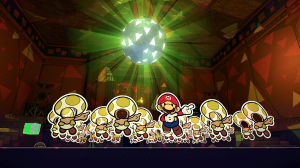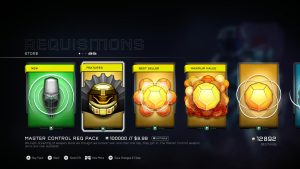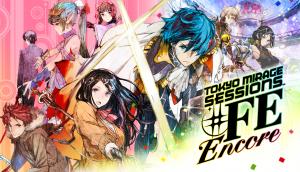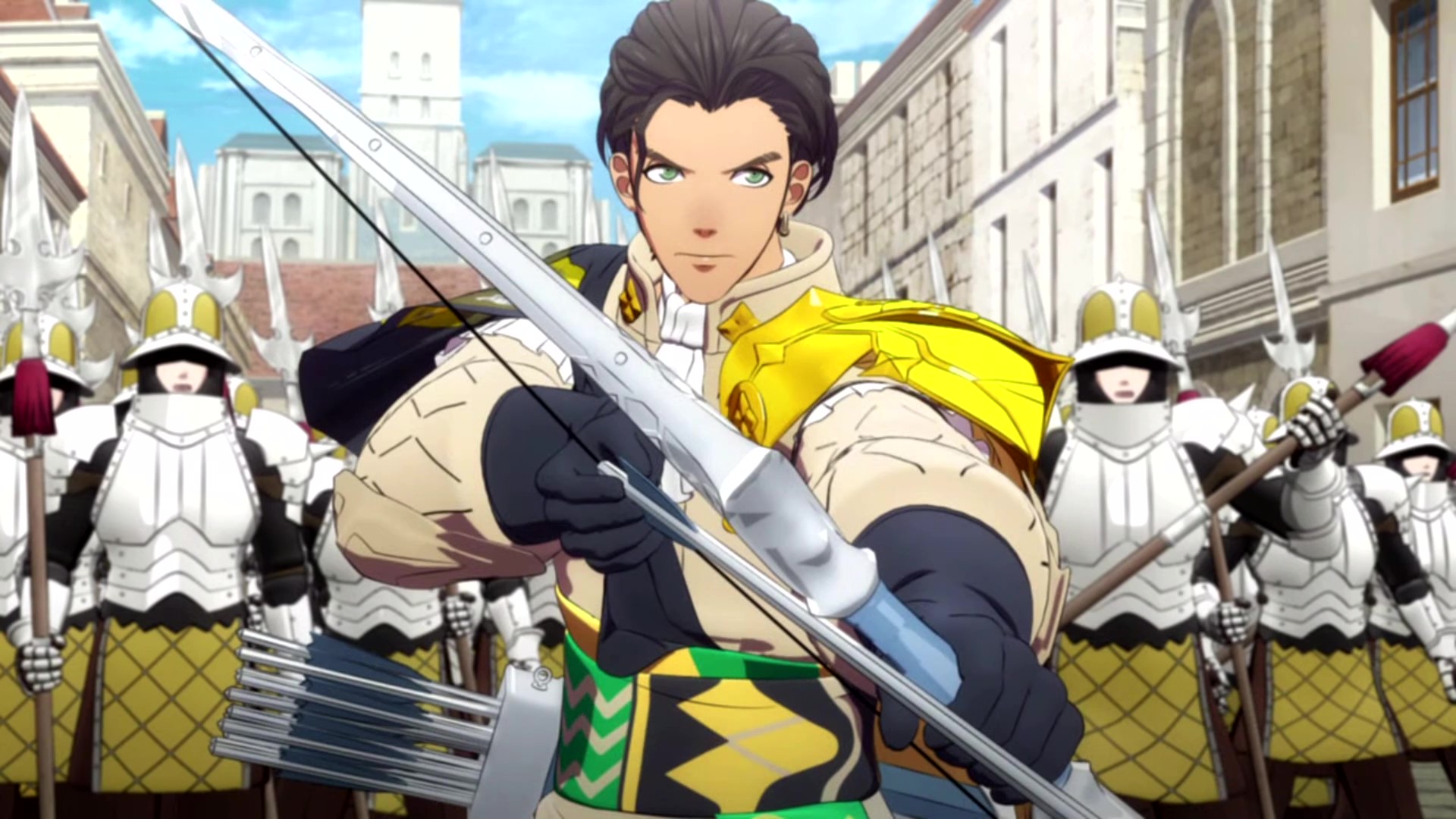
I’ve never been a fan of school, not in the slightest. No matter what genre, or medium, or reality I find myself in, slice of life school sequences are met with disinterest and impatience. I mean, Code Geass isn’t entertaining because Lelouch has to deal with school, it’s because he’s waging war against his former family to make the world a better place. That’s why I have to hand it to Fire Emblem: Three houses. The game managed to throw a slice of life school simulator in my turn-based strategy game, and managed to keep me so hooked that I started to neglect my responsibilities. Like actual school.
“Fire Emblem: Three Houses is a delicate juggling act, newcomers and veteran fans alike will probably find something they enjoy here.”
This came as a pleasant surprise to me. Ever since the success of Fire Emblem: Awakening, it’s felt like developer Intelligent Systems has had trouble figuring out what direction they wanted to take the series in. And as a long time fan, I felt disappointment every time they removed some core aspect of the game in favor of a more streamlined experience, and more fan-service. With Three Houses however, it seems Intelligent Systems is finally hitting a stride, bringing back and refining things that made the original games classics, and merging it with the charm that newer titles brought to the table. Fire Emblem: Three Houses is a delicate juggling act, newcomers and veteran fans alike will probably find something they enjoy here.
Oh, and strap yourself in for a long read. There is a lot of content to cover here. For the Tl;dr crowd, here’s a drop down index to help you navigate.
- Premise and Gameplay
- Exploring the Monastery
- The Calendar
- Instruction and Unit Growth
- Combat Mechanics
- Demonic Beasts and Monster Combat
- Map Design
- Difficulty
- Story
- Content and Replay Value
- Soundtrack
- Final Verdict
Gameplay: The Old, the New, and the Refined
Fire Emblem is a turn-based strategy series known best for having too many characters in Smash Bros its fantasy settings, charming characters, and challenging strategy gameplay. Its most iconic feature though is “perma-death”. Or in other words, once you lose a character in battle, they are gone for good, along with any side quest or support they would have added to the story. Ever since “Awakening”, every new entry in the series has also had a “Casual” mode, allowing for newcomers to experience the story without having to worry about death. After all, that’s what reality is for. Three Houses is no different. As soon as you begin you’ll be given difficulty options for a combination of Normal/Hard and Classic/Casual. (More on this later).
The premise of Three Houses is a unique one for the series. The game takes place on the continent of Fódlan, which is split in thirds by the major kingdoms. The player character, Byleth, is a mercenary who is hired (read forced) to teach for the officers academy at Garreg Mach Monastery, a neutral force in the center in the center of the continent. Byleth then chooses which house they want to lead: The Black Eagles, The Blue Lions, or The Golden Deer. Do not take this choice lightly. Every house has it own unique group of students and unique story events. From there, the story branches and Byleth must lead their house of students through the school year.
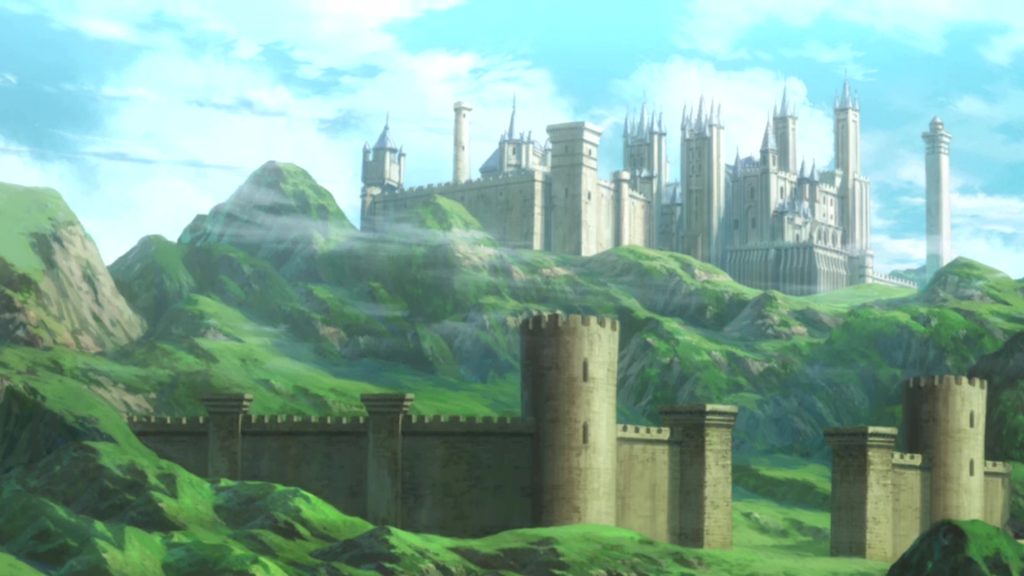
Before you choose your house to lead though, the game has you get to know your students, and introduces you to its biggest, new mechanic. Exploration of the monastery.
Byleth Wants a Quiet Life
Similar to the dungeon exploration from Fire Emblem: Echoes, minus the combat, you’ll explore the monastery in a third person, open world format. Acting as the base of operations, this is also where you’ll do the majority of combat preparations and after battle activities. Talking to students, fishing, cooking, and even answering an advice column, all of the activities performed while exploring have an impact on the game. The fish you catch can be cooked into meals. The meals will give your students different stat boosts depending on the ingredients. Giving good advice will boost motivation, making the student who asked more eager to learn during class. The more motivation a student has, the more you’re able to improve their skills before they give up.
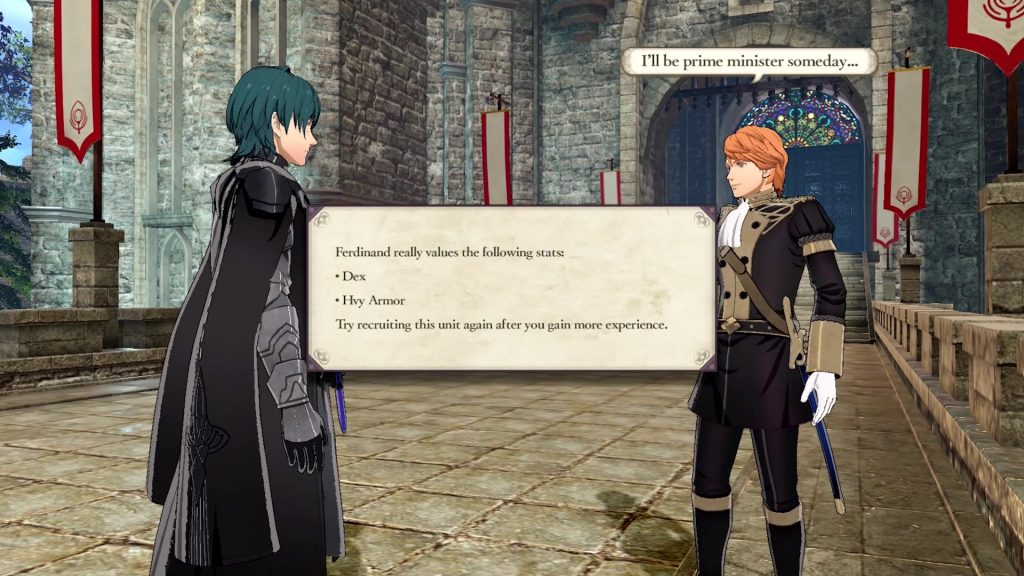
It’s also during these segments that you’ll have the opportunity to recruit students to your house. That’s right, aside from a few characters who’s allegiances are imperative to the story, you can recruit as many characters to your house as you please. All students will have select stats and skills that they wish to improve on during their time at the monastery. If Byleth can become proficient enough in those skills, the students will want to join their house in order to learn from them. However, there’s a cutoff point in the story to when you can recruit them. Between that and having to focus all the different stats, it’a technically impossible to recruit every single student. But with careful planning, you can build your own motley crew to join you in battle.
The Downside of Free Time
While exploring is a fun and charming break from war, it doesn’t come without its flaws. For one, a lot of the mini quests can get tedious, and downright boring. Most of them amount to finding a lost item, or collecting plants for some stranger. And while talking to everyone can get you interesting info that’ll give you insight into the lore, walking around the monastery to figure out who actually has anything decent to say starts to feel like a slog, even with the fast travel. To make matters worse, exploring multiple times the on the same month ends up being a waste of your Sunday. None of the dialogue changes and no new quests are added until the following month. All you can really do is fish and plant seeds.
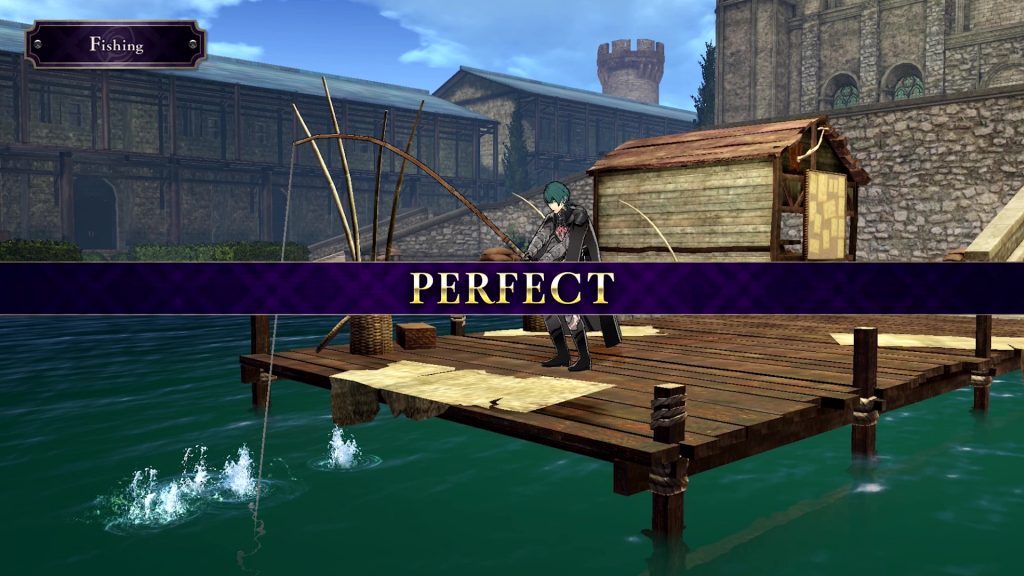
Thankfully, even though it can get boring at times, this segment never feels like it encroaches too much on the core Fire Emblem gameplay. In fact, if they had put more effort into the monastery activities, I probably would have enjoyed this just as much as the other aspects of the game. As it stands now though, it just feels like they were too afraid to go all in on the exploring, and it suffers for it.
And for those who don’t have the patience, you can skip most of it, even though I wouldn’t recommend that. Bonding with students and living a quiet life only adds to the already charming world of Three Houses.
“There cannot be a crisis next week. My schedule is already full.”
In order to make sure that no one part of the game gets too much focus, Intelligent Systems has the story follow a set, in-game calendar. The importance of the schedule is easy to overlook.
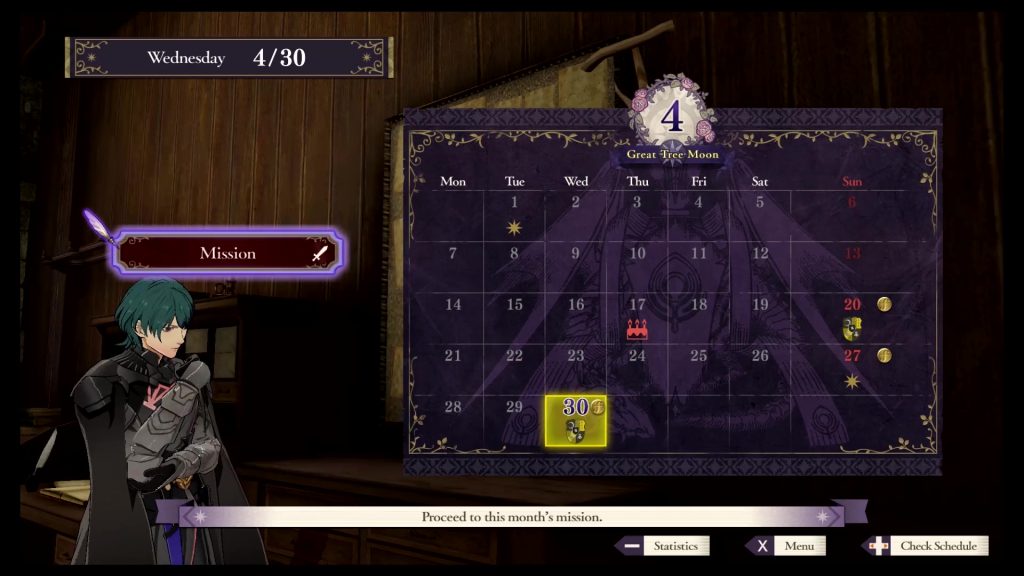
Along with with his new teaching gig, Byleth now has a strict schedule to follow. At the beginning of every in-game week, you teach the students. At the end of every week, you get a day off that you can use to your liking. Once the month ends, you take on a mission that progresses the story. While this sounds mundane, the calendar is used as a pallet cleanser of sorts, separating different aspects of the game in such a way that no one part overwhelms the other. On all the other days of the month, little actions occur that allow you to send gifts on birthdays or celebrate holidays. Partaking in these events will increase support levels between your units, and increase certain talents and stats depending on the holiday.
A Customizable Experience
The important thing here though is Byleth’s day off at the end of every week. On these days, you can choose whether you attend a seminar that increases skills depending on the instructor. Take a break, which will increase motivation for the entire class. Explore the monastery, which there’s no need to do more than once a month unless you enjoy it that much. Or you can take part in auxiliary and paralogue missions.
The calendar serves as a simple way for each player to customize their experience. If you want more exploring, choose to explore on your day off. If you want more combat, then simply go out to battle.
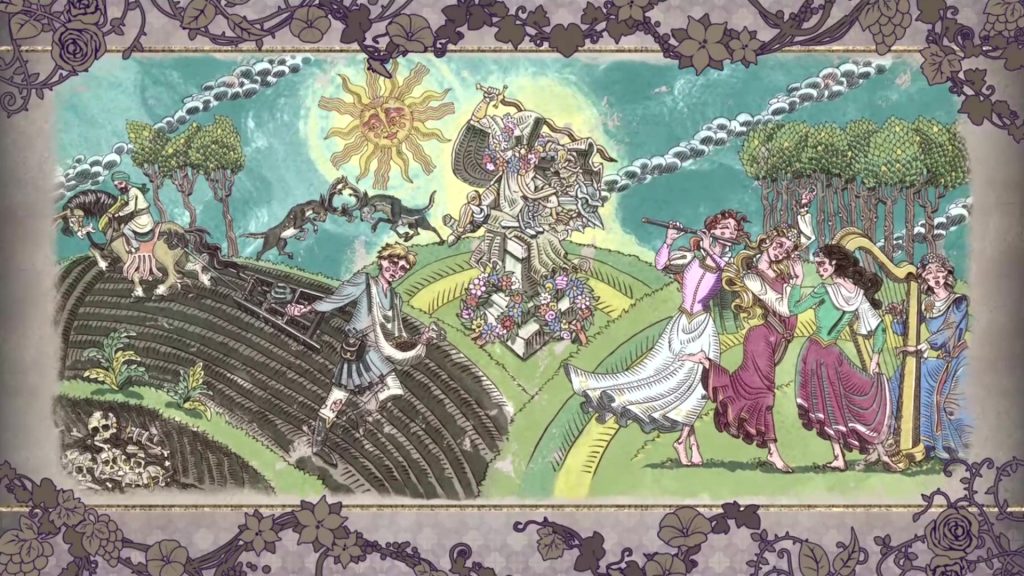
Also, at the start of every month, a cool cutscene with incredible art will play. It’s little things like this that show how much attention to detail was put into the game. The scenes explain how life in Fodlan changes along with the seasons and gives little tidbits of the continent’s history. It’s a very nice touch and builds on the game’s lore. Just another reason to like the calendar
Instruction time: Let’s Make a Man Out of You
Instructing your students at the beginning of every week is an incredibly effective mechanic, and marks a complete overhaul of how unit classes and weapon advantages work. In fact, I would even argue that the removal and replacement of the weapon triangle is one of the game’s greatest changes.
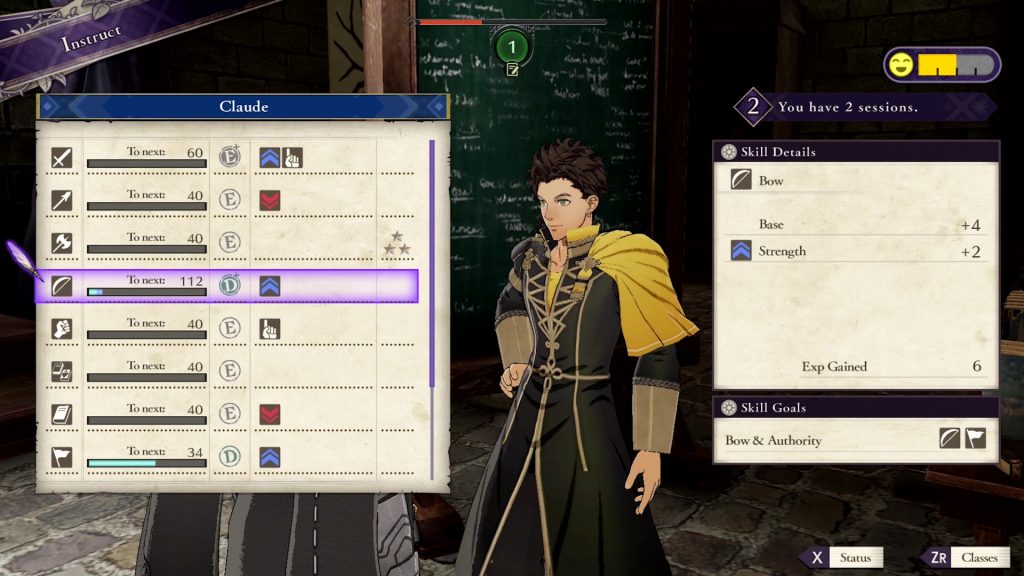
In older entries, the weapons a unit could use were directly tied to the unit’s class, but that’s no longer the case. All weapons are usable by any class of unit. Your students start off as complete novices, and each one has their own talents and interests that suggest where you should instruct them to improve. But those are just suggestions. If you want your mage to become a great knight, you can do that. If you have too many archers and think Claude looks better with an axe, then just teach him axe skills. Instead of a weapon triangle, units now learn weapon specific skills. For example, once a unit becomes proficient enough with a sword, they learn “Axebreaker” which when equipped will give a hit and avoid boost to sword users when going against an axe.
Player Choice and Freedom is a Trend in Three Houses
This new method of handling combat advantages and skills grants a new level of freedom to your army like never before in Fire Emblem. It also removes the power gap often seen in previous games where only one specific unit gets to shine. (*COUGH* Hector!). Anyone of your students can become a monster with the right teachings, and your attachment to those characters is that much stronger knowing that you helped them get there from nothing.
War Never Changes
Once you’ve had your fair share of fishing, and your students all know how to use their weapons, it’s time to march onto battle! Not much has changed when it comes to the iconic Fire Emblem combat system. If anything, it feels like a return to its roots this time around. Action is still turn based and players will still be giving directions to their units from a birds eye view of the battlefield. There’s also a new camera option that allows for a super close zoom of the action.
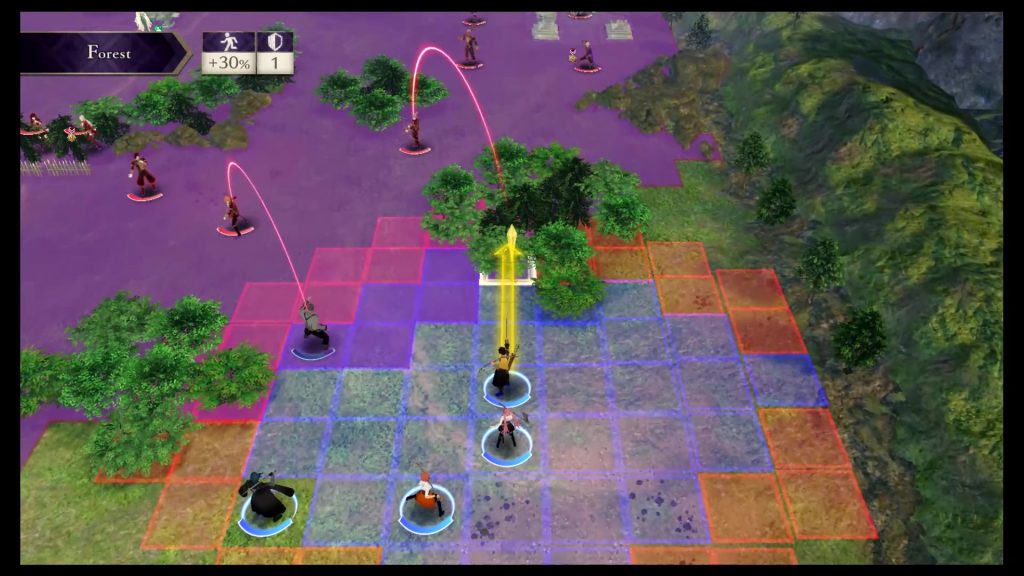
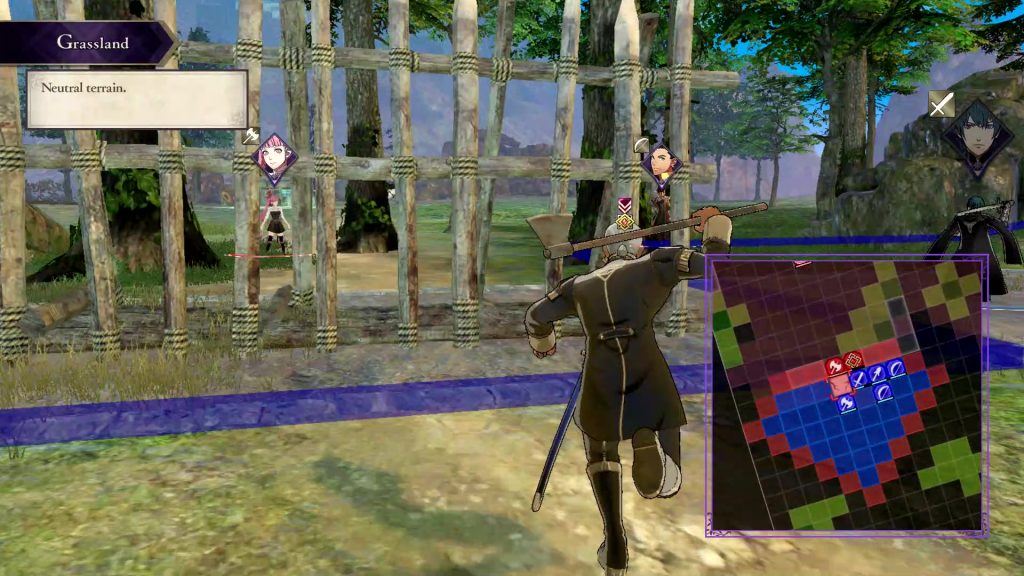
The attention to detail Intelligent Systems put into designing the battle sequences is wonderful. Watching the screen seamlessly transition from the over-world map to the up-close combat is a joy. Your units are no longer standing alone during combat either, being surrounded by battalions of their allies and enemies. This makes the battlefield seem less scarce and more like a grand spectacle.
Pair-up Attacks are Gone?!
They are in the traditional sense. Allies no longer randomly jump in to help attack or take a hit for you. Instead, when a unit goes to attack an enemy, they’ll get a slight bonus to accuracy, strength, and crit chance, depending on how many allies are adjacent to the enemy. Think of it as a bonus for flanking the enemy. While the boosts aren’t huge, they can make the difference in whether or not an enemy falls. The new mechanic makes a lot more sense than the pair-ups of old, and adds a lot more strategy instead of outright breaking the game.
Power in Numbers
The battalions that fight with your units aren’t just for aesthetics. Units are now able to perform Gambit attacks. During a Gambit, your units charge into battle with their battalions, doing massive damage and wreaking status effects on the enemy. Be careful though. If your unit finds itself in trouble, the battalion will retreat along with your option to Gambit. Depending on how high that unit’s authority stat is, they’ll be granted access to stronger Gambits and their battalion will be less likely to retreat in a pinch.
Weapon durability makes a long awaited return. Making sure my squad’s weapons weren’t going to break mid combat adds an appreciated level of depth to the game for me. Spending absurd amounts of time doing calculations for attack speed, damage output, and investigating enemy abilities mid battle is as rewarding as ever. There’s even a new feature that tells you which unit your enemies are going to target with the current positioning. This also makes exploiting enemy A.I easier, but is a welcome edition none the less.
Scary Monsters
Amongst the new features is the introduction of demonic beasts. These demons are huge, and take up multiple spaces on the map. Fighting them requires a strategy all on its own, as leaving them on the map too long can cause serious disaster. They often have multiple bars of health, and can be stunned by destroying the armor that surrounds them. They are also simple minded, meaning attacking them with a Gambit will draw their attention to the attacking unit. You can choose to overwhelm them with an all -out attack, or draw them out with well timed Gambits and finishing moves. In some maps, you’re even able to turn them on your enemies and watch on the sidelines. Either way, whenever these monsters appeared on the field, I had an awesome time fighting them.
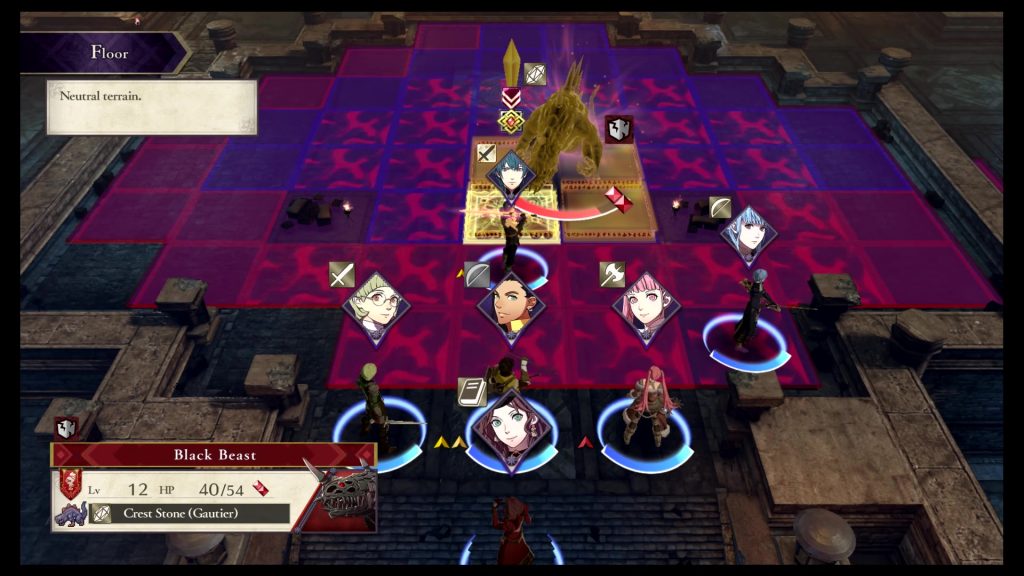
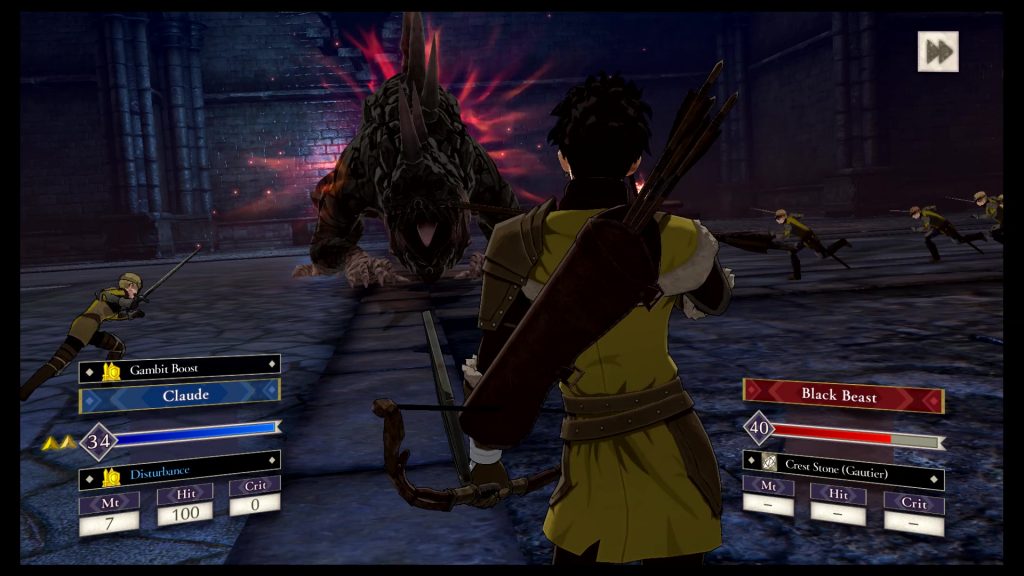
Map Design
Map design is where Three Houses starts to fall short. graphically and aesthetically, the maps are beautiful. However, they are HUGE! And while this works for a lot of them, some of the maps feel more like a march than a battle. Objectives are also very simple, often being “rout the enemy” or “defeat the commander”. Occasionally you’ll see a map that involves “don’t let the enemy escape” but there’s not much else. The sad thing is, I can see what Intelligent Systems was going for in a lot of the map designs, with well placed defense structures, and varied terrains. But the maps are so big that you often don’t even get to reach these structures because the battle will be over before you get there.
I feel like the maps were designed with different objectives in mind than what was released, especially since you visit some of them multiple times. But I’m not here to speculate, this is what we got, and while the majority of the maps were enjoyable, I’d be lying if I didn’t admit I exploited some of the more boring ones. Using a rescue/warp combo to immediately off the enemy commander was, sadly, an effective strategy on the maps I’m referencing here.
The Difficulty
Probably my biggest complaint with the game though is not having a difficulty beyond hard. Now I’m not going to sit her and pretend like like hard was too easy though. For my first playthrough I did a Hard/Classic run, and actually lost a few units. That being said, I did purposefully stop myself from using “Divine Pulse” a mechanic that allows you to rewind turns and can be used multiple times per battle. Hard tries to strike a balance between challenging and enjoyable, but it’s never good when someones only option for a greater challenge is to add their own rules.
Thankfully, game director Genki Yokota confirmed in an interview that they will be adding more difficulties in the future via a free update. My biggest hope is that the added difficulties make more clever use of the maps a necessity rather than an after though. Otherwise, if they simply raise the enemy levels and health, not having that option from the jump will be a huge letdown.
The Story (Minor Spoilers)
I’ll try to keep spoilers to a minimum and only talk about execution, rather than content. As it goes, after a year of Byleth living his quiet life as professor, war breaks out on the continent of Fodlan. Seeing the students come to terms with the cruel reality of war was heartbreaking. You watched and helped these characters grow, the last thing you want is to strike them down on the battlefield. The dialogue is well written, and paired with great voice acting. This is regardless of if you decide to use the original Japanese dub or the English dub, both of which are an option in the settings. Often times I would uproot my entire strategy just to have two students meet each other again, which always results in special dialogue depending on the characters.
Support Conversations are Executed Better
Helping you connect with the plight of the students is the return of support conversations. When two units spend enough time together on the battlefield, it triggers a series of conversations that helps you get to know them better. They’ll also gain stat boosts whenever they’re near allies they have supports with.
This time around the conversations are a lot less intimate, in part because units can no longer marry each other through supports. The exception to this is Byleth, who can choose who they marry on the final chapter of the game. This was an excellent decision, as conversations now feel like natural interactions and don’t quickly escalate from “You annoyed me that one time!” to “I love you, let’s have kids!”. Some conversations can only be unlocked after enough passage of in-game time, adding to the natural progression of supports as well.
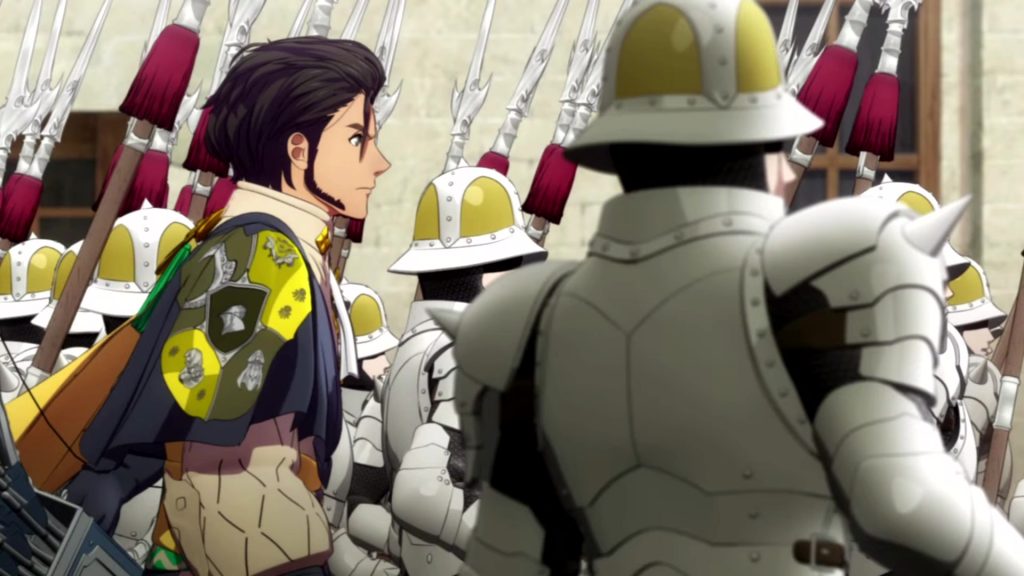
The Villains on the Other Hand…
I wish the writers put as much effort into the villains as they did in getting me to care about the students. Most of the antagonists feel rushed, with one villain even being killed off exactly one mission after their former introduction! No explanation into their motives or anything. Or at least I don’t think there was an explanation. There is so much story content and diverging paths in Three Houses, that I don’t want to jump to conclusions without experiencing the game multiple times. So I don’t think it’s an issue of bad writing but rather one of delivery.
Content
Your experience and perspective of the war will change dramatically depending on the house you chose at the beginning of the game. This is especially true when the time skip happens halfway though the game. A fleshed out villain on one path might feel like a mustache twirler on another. Some questions will be left unanswered, or others quickly explained and never expanded upon. Storytelling wise, it can be annoying. But this decision adds tremendously to the game’s replay value.
Every time you replay the story through a different house (there are actually four story paths), you get a unique experience and more pieces to this giant puzzle. A typical playthrough will run you a little over 60 hours, all with a unique group of characters and different stories. But all of that playtime means nothing if the game itself isn’t fun. Thankfully, Three Houses is exceptionally fun. The freedom it allows in choosing and growing your army means every dive back into the world will be a fresh experience.
The Soundtrack
No review of this game would be complete without mentioning the soundtrack. In a series known for its jaw dropping music, Three Houses did not disappoint when it came to this. And even though the music never hits any wrong notes, it really starts to take off during the games second half. The tracks become more solemn, more thrilling, and fit the mood of the game nicely. Keeping on par with the rest of the game’s attention to detail, all three routes have their own final boss themes too. If the others are as good as what I heard for my Golden Deer playthrough, then I can’t wait to hear them when I finally get there.
Final Verdict
Pros
- Return and refinement of classic Fire Emblem gameplay
- High amounts of content and replay value
- While the story isn’t groundbreaking, it’s entertaining enough and well executed
- Excellent audio! From the voice acting to the music
- High amount of attention to detail shows that the developers cared
Cons
- Exploring the monastery can feel like a drag at times
- Villains are shallow, and often introduced out of left field
- Not having a higher difficulty from day one is disappointing
- Lack of variety for mission objectives
- * I am not going to dock points for the small amount of maps that could’ve been handled better. Plus, different playthroughs go through different maps. Having only done The Golden Deer, I’ve yet to experience them all.
Being as objective as I possibly can, the game definitely has it’s flaws. Thinking as the huge fan that I am, this is easily the best Fire Emblem game I’ve played in a long time. Yes, there are corny villains, some of the maps can use some work, and the lack of variety in objectives is a little disappointing. None of this managed to ruin my experience when playing the game though. Immediately after finishing my first run, I started a new one eager to get back into it. Fire Emblem: Three Houses tries to cater to as many people as possible, an attempt that usually ends up breaking any game that tries. Despite that, Three Houses pulls off an excellent juggling act and ends up feeling like something greater than the some of its parts.
If there is one thing both my objective critic and inner fanboy can agree upon, it’s that Three Houses is a hell of a lot of fun, and both newcomers and seasoned veterans of the series will be glad to add it their Nintendo libraries.



